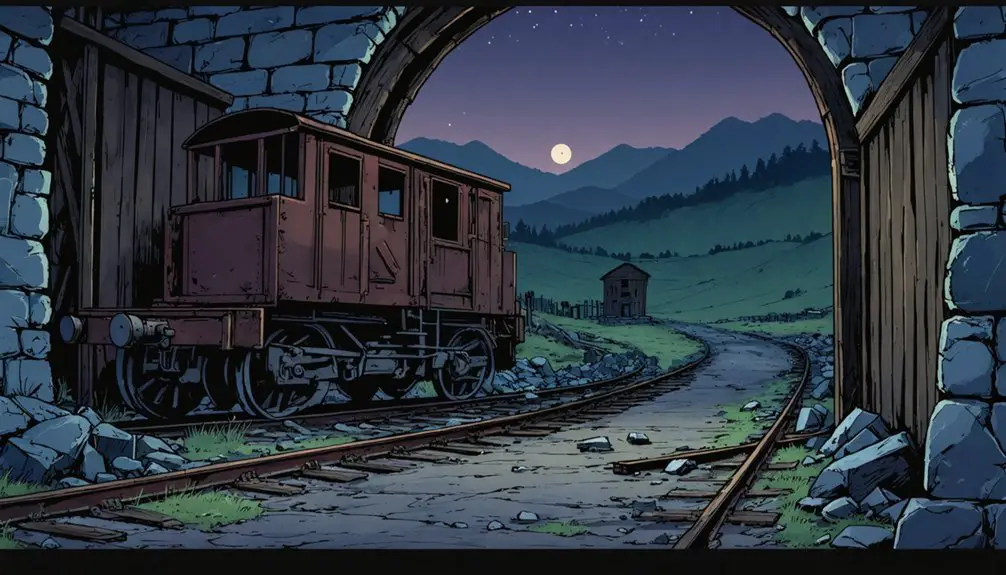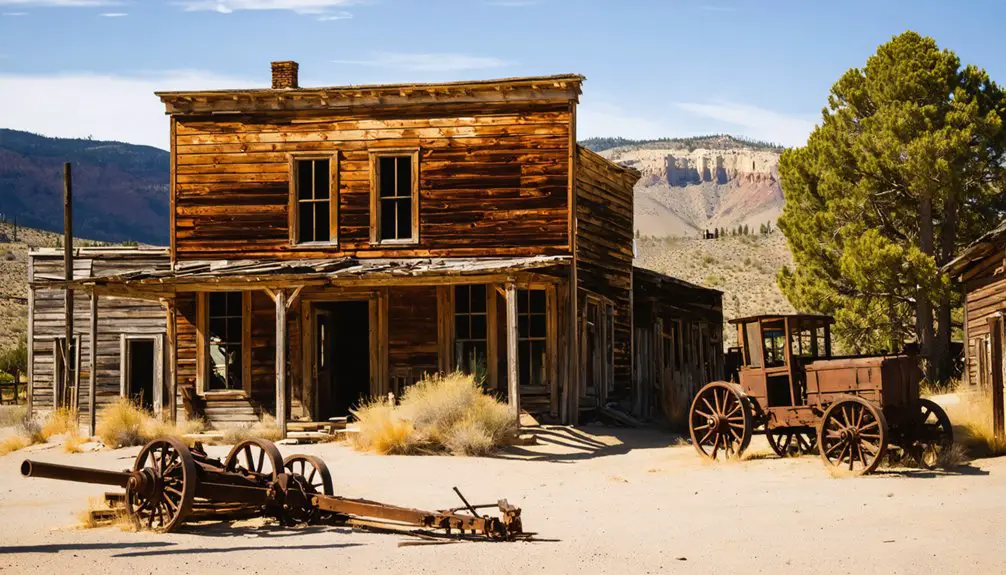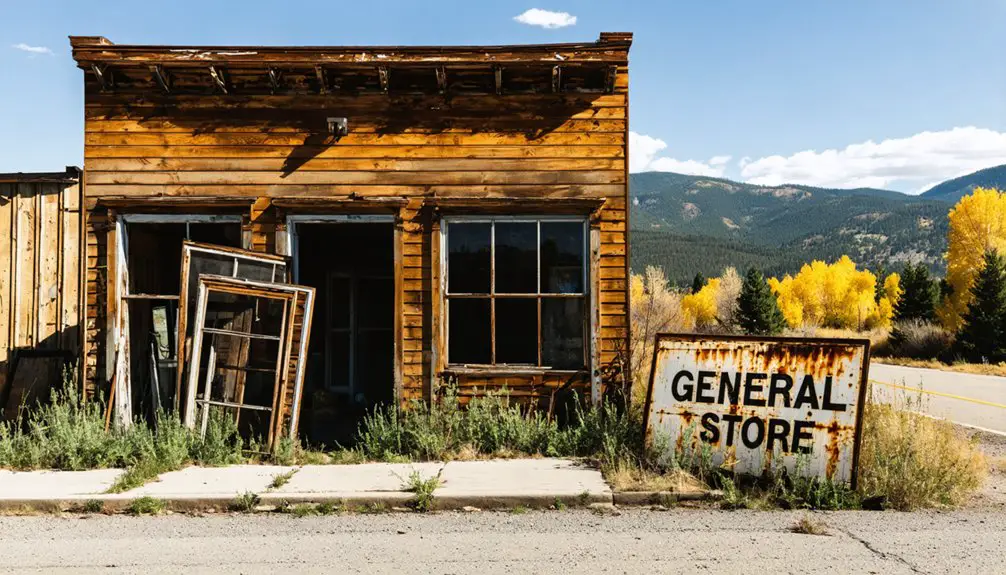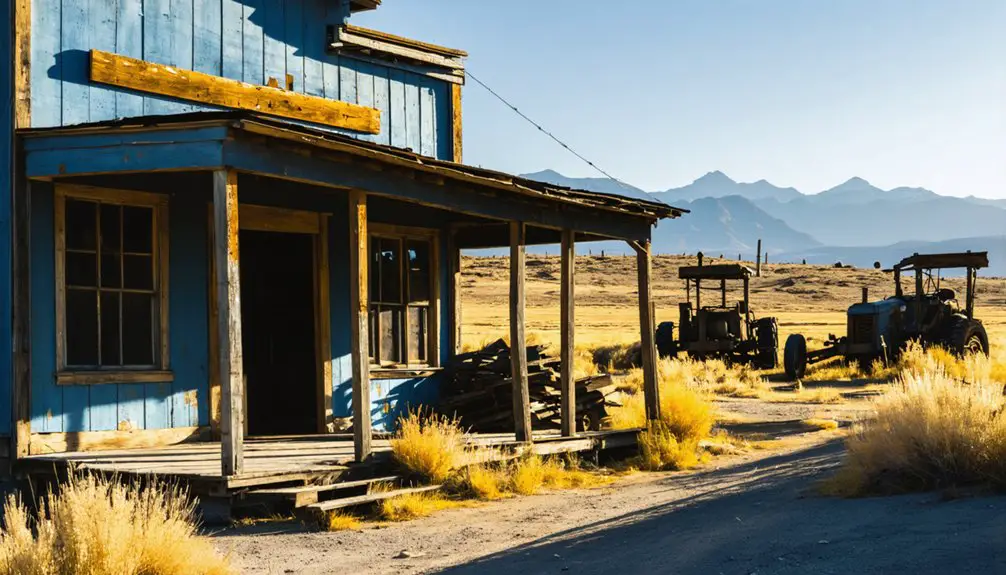You’ll discover Bonanza, Oregon’s origins as a thriving 1870s gold mining settlement that grew from a Modoc village near Big Springs. The town flourished after John Shook built a sawmill and named it “Bonanza,” meaning prosperity. Its Pacific Northwest’s largest free gold mine yielded up to $22,000 monthly under Geiser management. Today, crumbling structures and mining remnants tell tales of frontier ambition, tragic deaths, and mysterious circumstances that shaped this fascinating ghost town’s history.
Key Takeaways
- Bonanza began as a prosperous mining town in 1875, home to the Pacific Northwest’s largest free gold mine during its peak.
- The town declined after devastating fires between 1889-1897 and the closure of its last mine in 1913.
- By 1910, Bonanza’s population had dwindled to just four permanent residents, effectively becoming a ghost town.
- Original cabins and crumbling commercial structures remain as remnants of the town’s former prosperity.
- The ghost town sits near Big Springs along Lost River, with abandoned mining infrastructure still visible in the area.
The Birth of a Frontier Settlement
Three key developments marked the birth of Bonanza, Oregon, as a frontier settlement.
First, you’ll find the area’s indigenous settlement, where Modoc Indians established Nushaltkaga village near the life-giving Big Springs.
Then, in 1873, I.R. Chandler staked his claim as the first homesteader in Klamath County, though the Modoc War temporarily disrupted settlement plans.
The final piece fell into place when John Shook, returning from his duties as an Oregon State Militia scout, built essential early infrastructure by establishing a sawmill. By January 1878, the Ashland Tidings reported that the town showed great promise as a growing business hub. Like its Idaho counterpart, the town sat at an impressive elevation of 6,375 feet.
John Shook’s return from militia duty marked a turning point as his sawmill became vital infrastructure for the emerging settlement.
Shook later named the town “Bonanza,” meaning prosperity in Spanish, when applying for the post office in 1875.
Gold Rush Days and Mining Operations
While early settlers were still establishing the frontier town of Bonanza, prospectors discovered what would become the Pacific Northwest’s largest and most valuable free gold mine in the 1870s.
For ten years, the original locators worked the mine using the basic arrastra ore processing method, until Portland investors purchased it in 1885 and installed a ten-stamp mill.
After this venture failed, the Geiser Estate took ownership in 1891, expanding operations with a twenty-stamp mill, sawmill, and wire tramway system. The company was operated by the Geiser family members, including Louise Geiser, Emma Pullman, and Albert, Ed, and Frank Geiser.
Gold mining operations flourished under their management, yielding $20,000 to $22,000 in monthly clean-ups. The property was later discovered by Roy McDonald in 1900, who focused on developing its rich copper and gold deposits.
The mine’s rich ore contained both free gold and copper, with gold assays reaching up to 0.69 ounces per ton and copper content as high as 17%.
Life in Early Bonanza
Life in early Bonanza centered around a bustling agricultural community that emerged from a former Modoc village called “Nushaltkaga.” After I.R. Chandler filed the first homestead in 1873, settlers quickly established farms near Big Springs, taking advantage of the fertile soil and bubbling waters.
Like many frontier settlements that emerged during the Oregon Territory period, the town grew steadily as more pioneers arrived seeking opportunity. You’d have found John Shook’s sawmill as the town’s industrial anchor, while Albert Handy and Roberts’ general store served as the community’s gathering spot. The settlers carried weapons for protection, though their fears of Native American attacks were largely unfounded.
The town’s commitment to freedom and progress showed in their establishment of the county’s second school, ensuring children’s education remained a priority. Weekly stagecoach service connected you to Linkville and Lakeview, while Benjamin Price’s 1878 town planning created an organized settlement of eleven blocks.
Despite the earlier disruptions of the Modoc War, Bonanza’s residents built a self-sufficient community through early agriculture and trade.
The Kings’ Legacy and Local Legends
You’ll find evidence of the Kings’ influence in Bonanza through the Arcade Billiard Saloon and Yankee Fork Dance Hall, which Lizzie King operated while her husband Richard handled real estate ventures.
Richard’s story took a tragic turn when his business partner William Dillon murdered him in 1879 over a land dispute, making him the first person buried in Bonanza’s hillside cemetery. The cemetery sits up the mountain, with many graves reflecting the diverse ethnic backgrounds of early settlers.
Following Richard’s death, Lizzie maintained her prominent social position in the town, particularly through her close association with Charles Franklin, though her own story would later become entangled in local legends of jealousy and violence. Shortly after marrying Robert Hawthorne, Lizzie met a mysterious end when both were found dead just days later.
Richard’s Mysterious Death
Among Bonanza’s most enduring mysteries stands the tragic death of Richard, whose lifeless body was discovered inside his cabin clutching a locket with Lizzie King’s photograph.
Richard’s relationships became the subject of intense speculation, particularly regarding the alleged love triangle involving Lizzie and Robert. Much like the one murder per week that plagued Sierra Gordo during its peak, the mysterious circumstances surrounding Richard’s death sparked widespread fear and suspicion throughout Bonanza. Like many mining settlements, Bonanza faced harsh living conditions that tested the resilience of its inhabitants.
Key elements that fuel this haunting tale include:
- The peculiar placement of graves, with Lizzie buried between her two husbands
- Local accounts of ghostly sightings near Richard’s former cabin
- The unexplained circumstances surrounding the deaths of all three individuals
- The symbolic locket that suggests unresolved feelings between Richard and Lizzie
These mysterious details have transformed Richard’s death into a cornerstone of Bonanza’s ghostly reputation, drawing visitors who seek to unravel the truth behind this tragic pioneer tale.
Lizzie’s Saloon Days
One of Bonanza’s most influential pioneers, Lizzie King transformed the social landscape of this mining town when she opened the Arcade Billiard Saloon and Yankee Fork Dance Hall in the summer of 1878.
A London native known for her golden hair, Lizzie exemplified female entrepreneurship in the male-dominated frontier, establishing herself as a prominent figure through her thriving entertainment venues.
The saloon culture she cultivated made her establishment the heart of Bonanza’s social scene. You’d find miners and townsfolk alike gathering at her businesses, which formed essential networking hubs during the town’s mining boom.
Her close relationship with town founder Charles Franklin enhanced her influence, particularly after her husband Richard’s death in 1879.
Through her saloon operations, Lizzie left an indelible mark on Bonanza’s early development and cultural identity.
Mystery at the Mine: The Richard King Story

You’ll find Richard King’s tragic story woven into Bonanza’s early days, where his real estate dealings with William Dillon turned lethal at a local saloon in 1879.
The fatal confrontation erupted after Dillon allegedly sold land belonging to King, leading to a shootout that left King dead and Dillon sentenced to ten years in prison.
King’s widow Lizzie, with help from town founder Charles Franklin, chose her husband’s final resting place atop a hillside, making him the first soul laid to rest in Bonanza’s new cemetery.
Murder at the Saloon
Despite its ghost town status, Bonanza’s most perplexing mystery centers on the 2011 murder of 22-year-old Richard King near Trotter Court in Boston, often mistakenly conflated with the town’s violent past.
While saloon brawls and ghost stories have long defined Bonanza’s history, King’s tragic end stands apart.
You’ll find key elements that distinguish this case:
- King worked two jobs – delading houses and managing a Subway – far from Bonanza’s frontier setting.
- His final moments began with drinks in Boston’s theatre district.
- The crime scene revealed a deliberate, personal attack with multiple stab wounds.
- His burial at Boot Hill Cemetery mistakenly linked him to Bonanza’s violent era.
The case remains unsolved, with detectives still pursuing leads in what’s become one of Boston’s most haunting cold cases.
Love, Betrayal, and Death
When Richard and Lizzie King arrived in Bonanza from London in 1878, they couldn’t have foreseen the tragic sequence of events that would unfold. Their arrival sparked one of the West’s most intriguing ghost stories, centered on love triangles and betrayal.
After Richard’s death at the hands of William Dillon in 1879, Charles Franklin’s infatuation with the blonde beauty Lizzie became apparent. Though Franklin courted her, Lizzie chose to marry Robert Hawthorne instead.
Six days later, both were found dead in mysterious circumstances. The case remains unsolved, though many suspect a murder-suicide.
Franklin’s decision to inscribe only Lizzie’s marriage date on her headstone, and his death years later clutching her photo in a gold locket, hints at deeper passions that haunted Bonanza’s early days.
Natural Springs and Geographic Features
While many ghost towns struggled with water scarcity, Bonanza thrived due to its abundant natural springs and strategic location along the Lost River. The area’s spring ecosystems and consistent water flow shaped the town’s development from its Indigenous naming through its mining heyday.
You’ll find these key features that supported Bonanza’s survival:
- Multiple natural springs feeding into Bonanza Big Springs Park
- Year-round water availability due to mild climate and 300 days of sunshine
- Three surrounding valleys creating ideal conditions for water conservation
- Interconnected Lost River system supporting both mining and agriculture
The springs’ reliability transformed Bonanza from a mining camp into a sustained settlement, unlike many abandoned towns nearby.
These water sources continue supporting local agriculture and maintaining the town’s small but resilient population of 375 residents.
Landmarks and Historic Structures

Remnants of Bonanza’s glory days stand scattered across the landscape, telling stories of a once-thriving mining community.
You’ll find original cabins with distinctive architectural features like canvas walls and early double-glazed windows, though they lack modern amenities. The town’s cultural significance is evident in its thoughtfully planned layout, with tree-lined streets and a sophisticated water system that served both homes and mines.
While many commercial structures have crumbled to their foundations, the cemetery stands as a poignant landmark half a mile from town. Here, you can trace the community’s history through legible headstones.
Mining remnants, though mostly reclaimed by nature, hint at Bonanza’s industrial past through scattered equipment foundations and processing sites that you’ll discover throughout the area.
The Town’s Gradual Fade
Multiple fires in the late 1800s marked the beginning of Bonanza’s decline, with devastating blazes in 1889 and 1897 driving miners toward the nearby town of Custer.
Population shifts accelerated as economic decline took hold, and by 1913, the last mine had closed its operations.
The town’s fade unfolded through these key events:
- A series of major fires between 1900-1930 destroyed essential infrastructure
- The nearby mill in Custer drew away remaining workers and businesses
- Mining operations ceased completely by 1913, removing the town’s economic foundation
- Population dwindled to just four permanent residents by 1910
The repeated fires deterred rebuilding efforts, while the loss of mining activity sealed Bonanza’s fate.
What remained was a ghost town, its empty structures standing as silent witnesses to its former prosperity.
Exploring Bonanza Today

Today’s visitors to Bonanza encounter a stark portrait of mining’s aftermath, with deteriorating shacks and unstable ground marking this Oregon ghost town.
You’ll find the site largely untouched by ghost town tourism efforts, with minimal interpretation and only private property signs to guide your exploration. The gravel road leads you past massive dredge piles – rounded river stones that stretch for miles, creating a barren landscape resistant to environmental restoration.
A mile down an offshoot road, you’ll discover the old cemetery, where wooden “Unknown” markers stand among overgrown vegetation.
While Bonanza offers fewer preserved structures than other regional ghost towns, its raw state provides an authentic glimpse into mining history. The altered landscape serves as a powerful reminder of gold rush exploitation‘s lasting impact.
Frequently Asked Questions
Are There Any Dangerous Animals or Hazards Visitors Should Watch For?
You’ll need to watch for snakes and prepare for wildlife encounters. Take safety precautions against sun exposure, unstable terrain, and arsenic contamination. Don’t drink well water or explore mine shafts.
Can Visitors Legally Collect Artifacts or Minerals From the Site?
No, you can’t legally collect artifacts or minerals here. Federal mining regulations and artifact preservation laws strictly protect the site, with hefty fines and possible jail time for unauthorized removal.
What Is the Best Time of Year to Visit Bonanza?
When the sun’s blazing like a furnace, you’ll want to visit during summer months. You’ll enjoy perfect weather conditions and seasonal activities, plus you’ll have unrestricted access to explore historic structures.
Are There Guided Tours Available of the Ghost Town?
You’ll find guided exploration opportunities mainly during summer months, with knowledgeable guides offering tours that highlight the historical significance of mining ruins, buildings, and artifacts from the gold rush era.
Is Special Permission Required to Access the Cemeteries?
Playing it safe, you’ll need explicit permission per Oregon cemetery regulations. Private property signs mean you must contact owners first, though state law supports access for historical significance and genealogical research.
References
- https://www.youtube.com/watch?v=6hlviqR8cbk
- https://valereelane.wordpress.com/2015/02/11/bonanza-oregon/
- https://eaglepointgolf.com/southern-oregons-ghost-towns-provide-a-haunting-adventure/
- https://www.ghosttowns.com/states/or/bonanza.html
- https://www.nationaldaycalendar.com/lists/12-oregon-ghost-towns
- https://westernmininghistory.com/towns/idaho/bonanza/
- https://en.wikipedia.org/wiki/Bonanza_City
- https://www.legendsofamerica.com/id-bonanzacuster/
- https://accessgenealogy.com/oregon/bonanza-mine.htm
- https://goldrushexpeditions.com/mining_claim/bonanza-gold/



